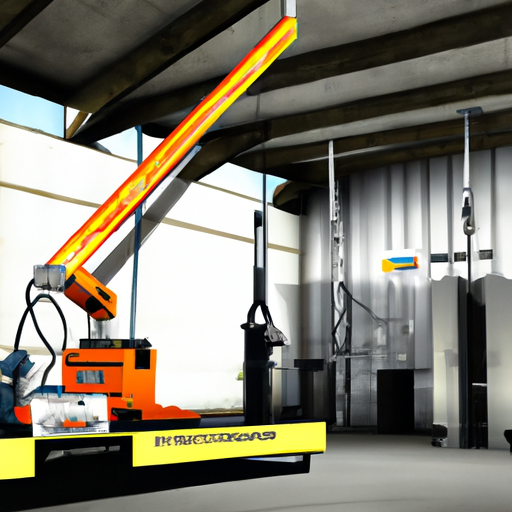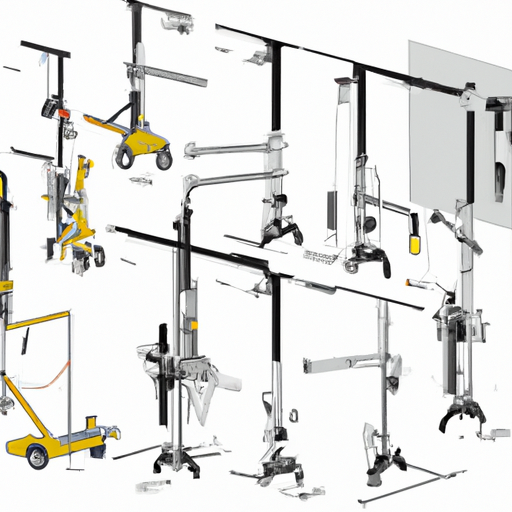
Are you tired of straining your muscles and risking injury when lifting heavy objects? Look no further because the solution is here: electric hoists. Electric hoists are a game changer when it comes to lifting and moving heavy loads effortlessly. Whether you need to lift goods in a warehouse, perform construction tasks, or simply need a reliable tool for your DIY projects, electric hoists are your ultimate ally. Say goodbye to backaches and hello to the convenience and efficiency of electric hoists.
Understanding Electric Hoists
Electric hoists are powerful lifting machines that are widely used in various industries and applications. They are designed to simplify and automate the process of lifting and moving heavy objects. Whether it’s in a warehouse, construction site, or even in your own home, electric hoists can make lifting tasks easier and more efficient. In this article, we will explore the definition of electric hoists, how they work, their importance, different types of electric hoists, components, applications, advantages, safety measures, cost and maintenance, as well as the evolution and future of electric hoisting. We will also provide guidance on choosing and installing the right electric hoist for your specific needs.
Definition of Electric Hoists
Electric hoists are mechanical devices that are powered by electricity and used for lifting and moving heavy objects. They consist of a main lifting mechanism, a power source, a control unit, a hoist motor, and a load chain or wire rope. Electric hoists are designed to provide efficient and safe lifting solutions for various industries and applications.

How Electric Hoists Work
Electric hoists work by converting electrical energy into mechanical energy to lift and lower heavy loads. The main lifting mechanism, which consists of a motor and a gearbox, generates the necessary power to lift the load. The motor is connected to a control unit, which allows the operator to control the movement of the hoist. The load chain or wire rope is attached to a lifting hook or a specialized attachment, which is used to lift and lower the load.
When the operator activates the electric hoist, the motor drives the gearbox, which then turns the load chain or wire rope drum. As the drum rotates, it winds up the load chain or wire rope, causing the load to be lifted. To lower the load, the motor is reversed, causing the drum to unwind the load chain or wire rope.
The Importance of Electric Hoists
Electric hoists play a crucial role in many industries and applications due to their ability to lift and move heavy objects with ease and precision. They help to increase productivity and efficiency by reducing the manual effort required for lifting tasks. With the use of electric hoists, workers can safely and quickly lift heavy loads, resulting in time and cost savings. Moreover, electric hoists provide enhanced safety features, making them a reliable choice for lifting operations.

Types of Electric Hoists
There are several types of electric hoists available, each with its own unique features and advantages. Understanding the different types can help you choose the right electric hoist for your specific needs. The main types of electric hoists include chain hoists, wire rope hoists, lever hoists, and trolley hoists.
Chain Hoists
Chain hoists are the most common type of electric hoist. They use a chain as the lifting mechanism and can lift heavy loads with ease. Chain hoists are versatile and can be used in various industries and applications. They are known for their durability, reliability, and ease of use.
Wire Rope Hoists
Wire rope hoists use a wire rope instead of a chain as the lifting mechanism. Wire rope hoists are typically used for heavier loads and longer lift heights. They offer smoother operation and greater lifting heights compared to chain hoists. However, they require more maintenance and are typically more expensive.
Lever Hoists
Lever hoists, also known as ratchet lever hoists or come-alongs, are portable and manual hoists that are commonly used in situations where electricity is not available or practical. Lever hoists use a lever mechanism to lift and lower loads. They are compact, lightweight, and easy to use, making them suitable for smaller lifting tasks.
Trolley Hoists
Trolley hoists are electric hoists that are mounted on a trolley, allowing them to move horizontally along a beam or track. Trolley hoists offer greater flexibility in terms of movement and can cover a larger area. They are especially useful in applications where the load needs to be moved to different locations.
Components of Electric Hoists
Electric hoists consist of several key components that work together to ensure smooth and efficient lifting operations. Familiarizing yourself with these components can help you understand how electric hoists function and how to properly maintain them.
Main Lifting Mechanism
The main lifting mechanism is the heart of the electric hoist. It includes the motor, gearbox, and drum or pulley system. The motor provides the power to move the hoist and lift the load. The gearbox converts the motor’s rotational motion into the linear motion required to lift the load. The drum or pulley system is responsible for winding or unwinding the load chain or wire rope.
Power Source
Electric hoists are powered by electricity. They can be plugged into a standard electrical outlet or powered by a battery. Some electric hoists even have the option to be powered by both electricity and battery, providing flexibility in different working environments.
Control Unit
The control unit is the interface between the operator and the electric hoist. It allows the operator to control the movement of the hoist, including lifting, lowering, and stopping. The control unit can be a simple pendant control with push buttons or a more advanced remote control system.
Hoist Motor
The hoist motor is responsible for providing the necessary power to lift and lower heavy loads. Depending on the type and capacity of the electric hoist, the motor can vary in size and power rating. The motor is usually connected to the main lifting mechanism and controlled by the operator through the control unit.
Load Chain or Wire Rope
The load chain or wire rope is the lifting medium that is attached to the load and used to lift and lower it. The load chain is typically made of high-strength steel and consists of multiple interconnected links. Wire rope, on the other hand, is made of several strands of wire twisted together to form a strong and flexible rope. The choice between a load chain and wire rope depends on the specific application and load requirements.

Applications of Electric Hoists
Electric hoists find a wide range of applications in various industries and settings. Their versatility and lifting capabilities make them essential tools for many lifting tasks. Some common applications of electric hoists include:
Industrial Use
Electric hoists are extensively used in industrial environments for lifting and moving heavy machinery, materials, and equipment. They are commonly used in manufacturing, assembly lines, production plants, and warehouses.
Construction Works
In the construction industry, electric hoists are used to lift heavy construction materials such as steel beams, concrete blocks, and scaffolding. They are essential for safely and efficiently transporting materials to different levels of a construction site.
Warehousing
Electric hoists play a vital role in warehousing operations, where they are used for loading and unloading goods, stacking pallets, and organizing inventory. Electric hoists enable efficient material handling and maximize storage space utilization.
Vehicle Maintenance
Electric hoists are used in automotive workshops and garages for lifting and lowering vehicles during maintenance and repair operations. They provide a safe and controlled way to lift heavy vehicles, allowing mechanics to access the underside of the vehicle.
Home Use
Electric hoists can also be utilized in residential settings for various purposes. They can be used to lift heavy objects such as furniture, equipment, and appliances during home renovations or when moving heavy items around the house.
Advantages of Electric Hoists
Electric hoists offer numerous advantages over manual lifting methods. Let’s explore some of the key benefits that make electric hoists a preferred choice in many industries and applications.
Efficiency in Lifting Heavy Loads
Electric hoists are designed to lift heavy loads with ease and precision. They provide a reliable means of moving heavy objects quickly and efficiently, reducing the time and effort required for lifting tasks. With the power of electricity, electric hoists can handle heavy loads that would be otherwise difficult or impossible to lift manually.
Decreased Labor Requirement
By using electric hoists, the need for manual labor to perform lifting tasks is significantly reduced. With the push of a button or the flick of a switch, operators can lift and lower heavy loads effortlessly. This not only saves time but also minimizes the risk of injuries and strain associated with manual lifting.
Safety Enhancements
Electric hoists are equipped with various safety features to ensure safe lifting operations. These features may include overload protection, emergency stop buttons, limit switches, and anti-reversal mechanisms. Electric hoists are designed to provide safe and controlled lifting, reducing the risk of accidents and injuries.
Range of Weight Capacity
Electric hoists are available in a wide range of weight capacities, allowing them to lift loads of varying sizes and weights. Whether you need to lift a few hundred pounds or several tons, there is an electric hoist available to meet your specific needs. This versatility makes electric hoists suitable for a wide range of applications.

Safety Measures When Using Electric Hoists
While electric hoists are designed to be safe, it is important to follow certain safety measures to ensure the well-being of operators and the integrity of the lifting operation. Here are some key safety measures to keep in mind when using electric hoists:
Proper Training and Operation
Operators should receive thorough training on the safe and proper operation of electric hoists. They should be familiar with the controls, safety features, and load capacity of the hoist. Operating procedures and safety guidelines should be adhered to at all times.
Routine Maintenance and Inspection
Regular maintenance and inspection of electric hoists are essential to ensure their safe and reliable operation. Maintenance tasks may include lubrication, checking for wear and tear, and inspecting cables or chains for damage. Any issues or defects should be promptly addressed and repaired.
Understanding Load Capacity
It is important to understand and adhere to the load capacity of the electric hoist. Overloading the hoist can lead to accidents or equipment failure. Operators should be aware of the weight limits and ensure that the load being lifted falls within the specified capacity.
Proper Use of Safety Features
Electric hoists are equipped with various safety features that should be utilized correctly. This may include emergency stop buttons, limit switches, and overload protection. Operators should be familiar with these features and know how to use them effectively in case of emergencies.
Cost and Maintenance of Electric Hoists
Understanding the cost factors and maintenance requirements of electric hoists is essential for making informed decisions about their purchase and upkeep.
Understanding Cost Factors
The cost of an electric hoist can vary depending on factors such as the type, capacity, brand, and additional features. Higher capacity hoists and those with advanced features may be more expensive. It is important to consider the specific requirements of your lifting tasks and choose a hoist that provides the best value for your investment.
Importance of Regular Maintenance
Regular maintenance is crucial for ensuring the longevity and optimal performance of electric hoists. Proper maintenance can prevent breakdowns, maximize the hoist’s lifespan, and ensure safe lifting operations. Neglecting maintenance can result in costly repairs and compromise the safety of the hoist.
Typical Maintenance Procedures
Maintenance procedures for electric hoists may include lubrication of moving parts, inspection of chains or wire ropes, checking electrical connections, and ensuring proper functioning of safety features. These procedures should be performed at regular intervals as recommended by the manufacturer or as indicated by the hoist’s usage.
Impact of Negligence towards Maintenance
Neglecting maintenance can have serious consequences, both in terms of safety and cost. Failure to properly maintain electric hoists can result in accidents, equipment malfunctions, and premature failure. This can lead to downtime, expensive repairs, and potential injuries to operators. Regular maintenance is a proactive approach that helps to prevent these issues.

The Evolution and Future of Electric Hoists
Electric hoists have come a long way in terms of technology and design. Let’s explore the evolution of hoisting technology and the future trends in electric hoists.
Historical Background of Hoisting Technology
The use of hoisting systems dates back to ancient times, where simple pulleys and ropes were used to lift heavy objects. Over time, as technology advanced, hoisting systems became more sophisticated. The invention of the electric motor in the 19th century revolutionized the hoisting industry, leading to the development of electric hoists.
Developments in Electric Hoisting
Electric hoists have undergone significant advancements in terms of design, efficiency, and safety features. Modern electric hoists are equipped with the latest technologies, including variable speed drives, digital control systems, and remote operation capabilities. These advancements have improved the efficiency, precision, and overall performance of electric hoists.
Future Trends in Hoisting Technology
The future of electric hoists is likely to be influenced by emerging technologies such as automation, connectivity, and artificial intelligence. Integration with smart systems and the Internet of Things (IoT) may enable remote monitoring and control of electric hoists. Automation and advanced sensors may further enhance safety and efficiency in lifting operations.
Choosing the Right Electric Hoist
Choosing the right electric hoist for your specific needs is crucial to ensure optimal performance and safety. Here are some key factors to consider when selecting an electric hoist:
Assessing Lifting Needs
Consider the weight and size of the loads you need to lift. Determine the maximum weight capacity required and the lifting height. This will help you choose an electric hoist that can handle your specific lifting needs.
Examining Product Quality and Safety Standards
Ensure that the electric hoist you choose meets the necessary quality and safety standards. Look for certifications and compliance with industry regulations. High-quality hoists are built to last and provide reliable and safe lifting operations.
Comparing Different Types and Brands
Compare different types and brands of electric hoists to find the one that best suits your requirements. Consider factors such as lifting capacity, durability, ease of use, and available features. Reading customer reviews and seeking recommendations can also help in the decision-making process.
Understanding Product Specifications
Pay attention to the technical specifications of electric hoists, such as motor power, lifting speeds, control options, and load limits. These specifications will help you determine if the hoist is compatible with your specific lifting tasks.
Installing an Electric Hoist
Proper installation of an electric hoist is essential for safe and efficient operation. It is recommended to seek professional assistance for the installation process. Here are some key steps to consider when installing an electric hoist:
Pre-installation Checks
Inspect the installation area to ensure it is suitable for mounting the electric hoist. Check the structural integrity of the supporting structure, such as beams or columns, to ensure they can withstand the weight and forces exerted by the hoist. Ensure that there is sufficient clearance and overhead space for the hoist to operate without obstruction.
Understanding the Installation Manual
Carefully read and follow the installation manual provided by the hoist manufacturer. The manual will provide detailed instructions and guidelines for proper installation. It is important to understand the specific requirements and procedures outlined in the manual to ensure a safe and successful installation.
Securing Professional Installation Services
To ensure a proper and safe installation, it is recommended to hire professional installation services. Experienced technicians will have the knowledge and expertise to install the electric hoist correctly, ensuring proper alignment, secure mounting, and appropriate electrical connections.
Common Installation Problems and Their Solutions
During the installation process, it is not uncommon to encounter certain challenges or issues. These may include difficulties with structural modifications, insufficient power supply, or compatibility issues. In such cases, it is best to consult with professionals or contact the hoist manufacturer for guidance and support.
In conclusion, electric hoists are valuable tools for lifting and moving heavy objects in various industries and applications. They provide efficiency, safety, and versatility in handling heavy loads. By understanding the different types of electric hoists, their components, applications, advantages, safety measures, cost and maintenance factors, as well as the evolution and future trends, you can make informed decisions and use electric hoists effectively in your lifting operations. Remember to choose the right electric hoist for your specific needs, follow proper installation procedures, and prioritize regular maintenance to ensure optimal performance and safety.









